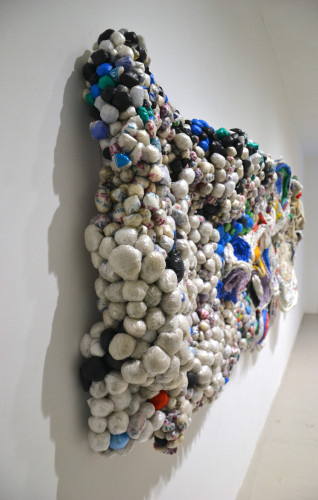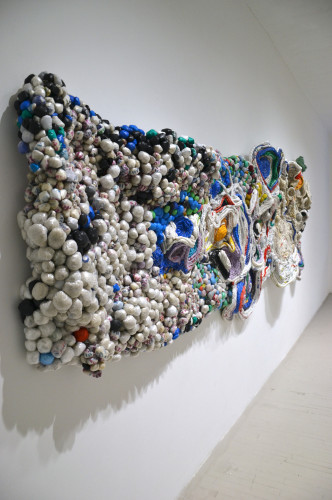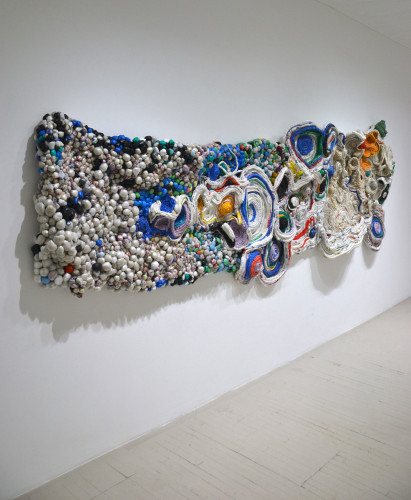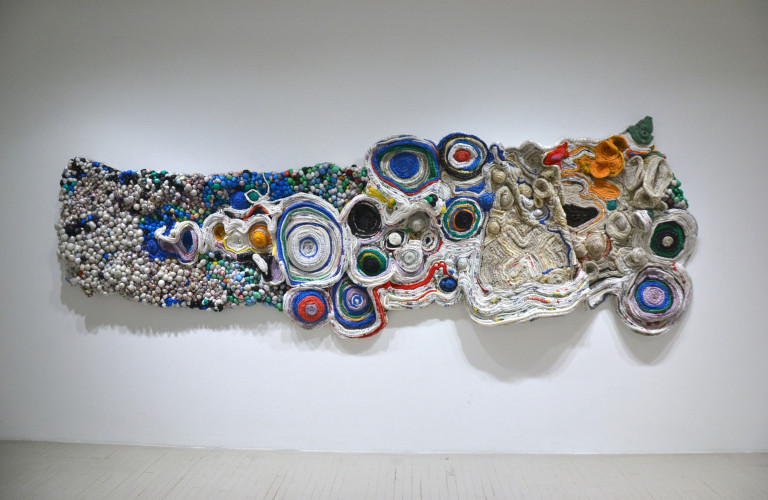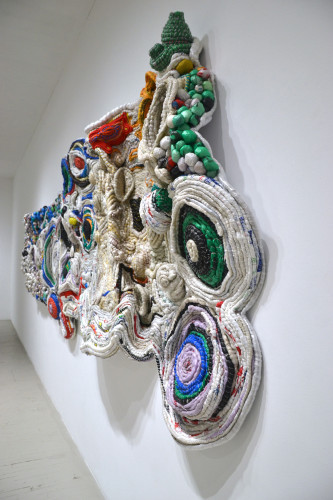
Ifeoma U. Anyaeji
Ifeoma U. Anyaeji is a neo-traditional Nigerian artist whose experimental approach to repurposing the discarded and documenting socio-cultural experiences, while commenting on modernity’s value-utility orientation plus its environmental effect, follows a non-conventional process. Engaging an eco-aesthetic practice, she developed and calls “Plasto-Art”, Anyaeji intuitively transforms her primary medium – used non-biodegradable plastic bags – by combining her crafting skills in traditional basketry and an age-old Nigerian hair plaiting technique called “Ikpa isi owu”(in Igbo) or "African Hair Threading".
Using this craft-art technique to combine and harmonise her medium with reiterations of her traditional Igbo experiences, Ifeoma inventively eliminates predictable expectations, and spontaneously creates bold compositions that demonstrate a persistent mastery of the technique. The compositions are intricate sculptures and installations that are vibrant and conceptual yet organic. Rhythmically infused with traditional metaphors which continuously echo her ‘Igboness’ and craft-art ideologies, these works reference architectural forms, domestic spaces and furnishings, including silent discourses on the human body. By spontaneously engaging the “old”, Ifeoma’s works question the implications of modernity's consumptive systems of mass accumulation and waste generation, definitions of cultural assimilation and society's attitude to value, the expiration-date syndrome, colonial orientations on beauty, adaptation, authenticity, and newness. Anyaeji has had various exhibitions within Africa, Europe and North America with her works in private and institutional collections and is currently pursuing a doctoral degree.
-
Plasto-art
+Plasto-art – is a craft-art process of making that Ifeoma U. Anyaeji coined which refers to repurposing and reformulating the utility of discarded non-biodegradable plastic bags using a receding Traditional Nigerian hair craft practice while also re-establishing traditional Igbo values.
-
Ifeoma U. Anyaeji–About her artwork titled ‘Eze Fuo eze anochie’
+In 2013, during an artist residency in Nairobi, Kenya, I created a sculpture which I titled Eze Fuo eze anochie (when one King leaves another replaces him, meaning no condition is permanent), culled from the Igbo proverb “Eze Fuo eze anochie” (which is interpreted to mean that no situation is constant and nothing stays the same infinitely– also similar in meaning to the Nigerian saying “No condition is permanent”). This sculpture was fulfilled as an interpretation to an unexpected climatic and culture shock I experienced while in Nairobi. Since I grew up in the warm tropical temperatures of Nigeria, with an assumption and specific view of how neighbouring African cultures sustained their heritage past their colonial histories, my expectation of Nairobi (Kenya) was not to be different from my experiences in Nigeria. However, the reality of my stay in Nairobi was contrary to assumptions I had of the place and what I had hoped the culture would be. While I could see how deeply seated the Euro-centric mannerism of existence was quite present in this East African country, making the socio-cultural environment far more alienating to me, I also could not comprehend the climatic difference since the country was close to the equatorial belt. The wintery weather I was experiencing during that period affected how I worked and lived during my residency. At the beginning I was reclusive, balled up and hesitant to engage with the people and the environment. This ‘new’ climatic change and replacement of the warm African heat that I knew by a weather so cold like the Fall-Winter temperatures of the places I had visited in North America and Europe, made me query what I had always believed was the idyllic equatorial and sub-Sahara Africa.
But as I came to terms with these new moments, I slowly became appreciative and more open to embracing those experiences in order to have a successful stay. Like every other Plasto-art work I had created, the work became a part of my continued journey to aesthetically document or journalize how I have chosen to perceive everything around me. By either adapting to the changes in cultural perception that continually modifies my environment or using my cultural knowledge to revise the changes in my environment. Especially in line with my neo-traditional practice, where the key focus is on the impermanence and perpetuity of value in the composition and sustenance of all aspects of our ecosystem–from cultural to biological. Furthermore, besides been an anthropological journal of my Kenyan visit, the work Eze Fuo eze anochie, metaphorically speaks about the continuousness of change, its effect in the replacement (or compromise) of indigenous values. It also embraces practices of my ethnic existence, to include a spoken language deeply saturated with a sagacity that can be applied outside its conventional fora. Yet, like many other aspects of indigenous material and non-culture, is faced with the risk of stagnation brought on by the pressures of today’s lobsided globalized ethnic contemporaneousness. Where what was once prolific, like traditional craft processes, art forms or the speaking of local languages in common spaces without apprehension, becomes overtaken by foreign guidelines on proper communal mannerism and unified language restrictions.
In decentralised pre-colonial Igbo history, the political system did not allow an Eze (king) to have absolute authority because it was believed that every member of each Igbo community was a part of the decision-making cabinet and contributed collectively to its administrative matters and social value up keep. Therefore, authority was a collective responsibility of everyone. It is in this same spirit of shared responsibility in deciding how our environment should be that I perceive my role as an advocate for the non-ephemerality of material and non-material culture and a harbinger of my Igbo origin. Thus, with every work I create, I have mandated myself to push for displaced traditional customs and modes of identity to always take their place as Ezes by tapping into their history and reformulating them the same way I have chosen to transform the discarded material to recreate a new environment.
